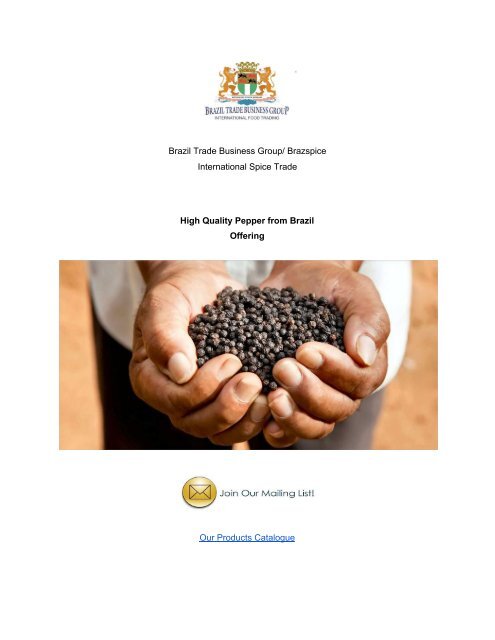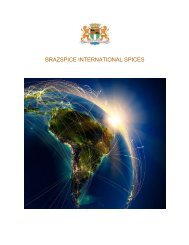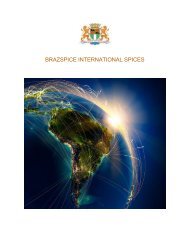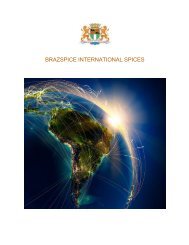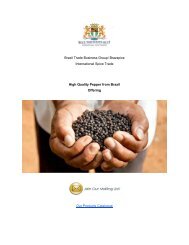Create successful ePaper yourself
Turn your PDF publications into a flip-book with our unique Google optimized e-Paper software.
<strong>Brazil</strong> Trade Business Group/ <strong>Brazspice</strong><br />
International Spice Trade<br />
High Quality <strong>Pepper</strong> from <strong>Brazil</strong><br />
Offering<br />
Our Products Catalogue
BLACK PEPPER ASTA - B1 - B2 - FAQ<br />
WHITE PEPPER ASTA - W1 - W2<br />
PINK PEPPER G1 - G2<br />
PINHEADS PEPPER<br />
SKIN WHITE PEPPER<br />
BLACK PEPPER IN POWDER<br />
Grades Black <strong>Pepper</strong>:<br />
Our <strong>Pepper</strong> Quality Specification<br />
ASTA quality 580 gr/l<br />
B-1 quality 560 gr/l<br />
B-2 quality 500-520 gr/l<br />
Grades White <strong>Pepper</strong>:<br />
Our <strong>Pepper</strong> Quality Specification<br />
White pepper ASTA quality 590 gr/l<br />
White pepper W.1 quality 560 gr/l<br />
White pepper W.2 quality 500-520 gr/l ( difficult to find, please consult us)<br />
White pepper from <strong>Brazil</strong> is a bit more white and cleaner than if compared from Vietnam.<br />
<strong>Pepper</strong> – (Piper nigrum L.) belongs to the Piperaceae family, and is a native of southern<br />
India. <br />
<br />
Offers of High Quality pepper from Para state, Espirito Santos state, <strong>Brazil</strong>, directly from our<br />
warehouse in Itu City - Sao Paulo estate ready for shipment. Our supplier is a exporter of high<br />
quality <strong>Pepper</strong> and Spices since 1997 and has a branch in the production area of the producers.
In Pará state ( North <strong>Brazil</strong> ) the <strong>Pepper</strong>s has more brownish pepper.. and the grains are (in<br />
general) small, and the grains (shell) are rumpled, in Pará there are not smooth shell … there<br />
are rumpled pepper.<br />
In Espirito Santos state (Southeast <strong>Brazil</strong> ) pepper are more black, big grains, and more<br />
quantities of smooth grains but of course there are some grains similar from Pará.. because<br />
there are some lots that some farmers continue to use the method of Sun dried of Pará, but the<br />
tendency of the market is use (short time) only big ovens.<br />
<strong>Pepper</strong> in <strong>Brazil</strong><br />
<strong>Pepper</strong>, Piper nigrum, is a plant of the Piperaceae family, native to the south of India. The<br />
pepper arrived in <strong>Brazil</strong> (Bahia) in the 17th century. However it is only in the Thirties that<br />
Japanese immigrants introduced a variety closer to the pepper consumed today.<br />
There are three main producing regions:<br />
●<br />
●<br />
●<br />
The Para, on average 30.000 tons, mainly in the regions of Castanhal, Volume-Açu,<br />
Guamá and Paragominas.<br />
Espirito Santo, on average 8.000 tons, mainly in the area of São Mateus.<br />
Bahia, 3.000 tons, primarily in the south of the State.<br />
<strong>Pepper</strong> growing is mainly a family activity bringing resources to approximately 150.000<br />
people.<br />
The harvest generally starts in August in the Para and in July in Espirito Santo. It ends in<br />
October. This spice is dried artificially with the help of mechanical dryers.<br />
<strong>Brazil</strong> Trade Business Group works with the best suppliers of Bahia and Espirito Santo.<br />
Harvest<br />
The crop season in <strong>Brazil</strong> is divided in 3 periods of the year.<br />
● Espirito Santo, Bahia and Southeast regions, there are two crop periods: June/July +<br />
December/January<br />
● Pará State, the Northern region of <strong>Brazil</strong>: August/September/October - White <strong>Pepper</strong><br />
only available by October and November.<br />
Black/ White/ Pink <strong>Pepper</strong> HS Code: 0904.11.00<br />
Skin White pepper - Black pepper in powder<br />
Packing: Paper bag ( one plastic bag inside, and covered of double sheet paper. No<br />
classification, approval of samples.
Cleaning our <strong>Pepper</strong>: Quality control:<br />
All of our products offered are under strict quality control, in which all process steps are<br />
monitored and controlled, based on strict International quality standards. <br />
Our supplier does not use any chemical product, any steam sterilization, or irradiation (except if<br />
the customer ask),to clean pepper. To clean pepper they use a systems of screen, wave,<br />
machine of ventilation.<br />
● ASTA’s (USA) Cleanliness Specifications establish limits for macroscopic extraneous<br />
matter for domestic and imported spices, seeds and herbs coming into the United<br />
States. <br />
● Recleaned; ( Europe ) systems of screen, wave, machine of ventilation.<br />
● Fumigation is always done with Phostoxin.<br />
● Sterilization Steam sterilization will be available soon.<br />
● ETO, means Ethylene Oxide Sterilization process, NOT available.<br />
● Irradiation- sterilization service possible, but will be high in cost . Please consider to do<br />
this service in your own country. If needed we are able to assist in <strong>Brazil</strong>. Cost: 0.20<br />
USD/kg. The USA & Canada allowed you to do Irradiation- sterilization in the USA &<br />
Canada.<br />
<br />
Quotes/ Offer validation: 24 hours<br />
Offers :<br />
Please contact us for current pricing. Due to constant fluctuations in market prices it is<br />
impossible to post a constant fixed price.<br />
Prices offered are valid for confirmation only if all terms of the contract are agreed by both Buyer<br />
and Seller. Seller reserves the right to change the offer prices before full agreement on all<br />
contractual terms.<br />
Payment: 100% by irrevocable and confirmed L/C is acceptable, or 30% anticipate payment<br />
and sold payment by copy of documents by fax (the original documents will be send directly to<br />
the customer after receipt of 100% payment transfer in our bank)<br />
We are able to accept CAD in bank.<br />
Black/ White <strong>Pepper</strong><br />
Package: Double poly bags, 50 kgs or 25 kgs each. If needed we offer 25kgs Paper bags.<br />
● we can load in bags of 25kgs. Net ( 60cm x 90 cm) – 70 grs.<br />
● We can load in bags of 50kgs. Net ( 70 cm x 1,00 cm) – 100 grs.<br />
Labels: the etiquette will be paste on the plain bag in 2 languages: English and Portuguese, or<br />
English and Spanish or just English + LOGO Supplier.<br />
Etiquette:
● <strong>Pepper</strong> Type ----<br />
● Net Weight: 50 Kgs<br />
● Lot: 0326/KT-12<br />
● Validity date: -----<br />
● Product of <strong>Brazil</strong><br />
Minimum order: Container 20', 15 tons (300 bags) +- USD 120,00 p/ ton shipping cost less if<br />
the customer accept the shipment in container of 40 feet.<br />
Lead time: 10 to 15 days to put on port. (time count from advance payment)<br />
Shipping:<br />
- Container 20', 15 tons (300 bags)<br />
- Container 40', 27 tons (540 bags) - the quantity (tons) always depends on the destination law.<br />
We accept NVOCC ( Carga Consolidada )<br />
Terms of delivery: FOB, C&F,CIF, DDU<br />
Port of loading: Santos <strong>Brazil</strong>.<br />
Documents provided:<br />
● Invoice<br />
● Packing list<br />
● Bill of lading<br />
● Analysis of Salmonella<br />
● Other microbiologic certificates can be offered but needs to be added to the final price<br />
offer.<br />
● SGS certificate, ad to the final price offer<br />
● Fumigation certificate ( 72 hours with Aluminum phosphide )<br />
● Quality and weight certificate<br />
We provide to all customers, to all shipment => our certificate of Salmonella – this is free<br />
All others types of certificates , like :<br />
● Bacillus Cereus
● Aflatoxine<br />
● Mould and yeast<br />
● Bacteries total account<br />
● Escherichia coli<br />
● Classification<br />
● Etc<br />
will NOT be provided free of charge. If needed, please note to fill in a request at the beginning of<br />
the business, and before shipment. After shipment we are unable. The cost of requested<br />
certificates will add to the cost of the price of our final offer, and might delay the shipments as<br />
some certificates are expensive and are taking time to conclude.<br />
As of March 2014 the <strong>Brazil</strong>ian Customs are not issuing a Phytosanitary Certificate as being<br />
not needed anymore International.<br />
Non GMO: normally we issued our own certificate of non GMO if needed.<br />
Export: Europe/ North Africa/ Canada/ USA/ South - America Central/ South America South<br />
FDA registered.<br />
Waiving Taxes: <strong>Brazil</strong> is one of the largest Exporters of <strong>Pepper</strong> Worldwide and for promoting<br />
Exports the <strong>Brazil</strong>ian Government is waiving taxes on <strong>Pepper</strong> Export<br />
Courier service: in our region the best services is TNT or FEDEX. DHL is not prefered.<br />
Free samples on request.<br />
● As a general rule, samples provided not against a stipulated contract might not represent<br />
the exact lot that will be shipped.<br />
● In case of "analyze" / any lab control, we would need to hold a specific lot, which should<br />
be discussed specifically.<br />
● Offering samples once order is confirmed. For new enquirer we kindly ask you to use<br />
your own TNT/DHL/FEDEX account to send the sample.<br />
Please inform us about your sample quantity and type needed, your courier account number,<br />
sample receiving address, company name, address and telephone and country samples<br />
restrictions, documents and receiver tax code if needed. Each country has their own<br />
regulations.<br />
Please be advised that the samples might need to be inspected by the Health and Agricultural<br />
department of your country which could involve a Consignee Taxes payment. Please check with<br />
your Courier.<br />
In some cases a clearing agent (or your courier) is required at the consignee's end. A clearing<br />
agent at the consignee's end makes clearance a lot simpler and we always recommend it for<br />
our customers. We normally send a certificate of origin and a Proforma invoice stating it’s a<br />
sample and a low value, with all shipments.
We advise Fedex for sending samples, since fedex has customs representatives that speed up<br />
the process. TNT and DHL do not, therefore it take longer and if detained, it will take too long.<br />
Black <strong>Pepper</strong>:<br />
Black <strong>Pepper</strong> is obtained by drying the ripe green berries. It is widely used by the food industry,<br />
in processed meat and in confectionery products. Black pepper is mostly used in three forms -<br />
powder, oil and oleoresin. Most countries import whole pepper berries and convert them into<br />
powder. Quality-conscious food processors prefer whole black pepper since the pepper oil,<br />
oleoresin and the flavour of the original spice are retained in them. USA is the main market for<br />
black pepper.<br />
White <strong>Pepper</strong>:<br />
White pepper is prepared from the optimally mature peppercorns. The berries are kept under<br />
running water for 7 to 9 days to soften their pericarp. After removing the pericarp by scrubbing,<br />
the white peppercorns are washed and dried. White pepper is mainly used in the preparation of<br />
light-coloured dishes, sauces and soups. West Europe constitutes the major market for white<br />
pepper.<br />
Ground <strong>Pepper</strong>:<br />
Dried pepper berries today are commercially ground using various types of mills, depending on<br />
the user’s specifications (i.e., particle size, volatile-oil content, etc). Critical factors like grinding<br />
temperature, hygiene and packaging affect the quality of ground pepper. The producing<br />
countries have a number of spice grinders to grind pepper and other spices, with a variety of<br />
machines that run on basic technology as well as sophisticated cryogenic systems.<br />
Green <strong>Pepper</strong>:<br />
Green pepper is made from the fully developed but immature berries. They are preserved in<br />
brine, vinegar or citric acid and may be dried or kept in the preservative. Europeans are<br />
fascinated by the natural green colour and fresh flavour of green pepper.<br />
Canned Green <strong>Pepper</strong>:<br />
The separated green pepper berries are washed and filled in cans containing a diluted solution<br />
of sodium chloride with or without added acidity. The filled cans are then sealed and sterilized<br />
by the autoclave process, and cooled under running water. Europe, USA and Australia use<br />
canned green pepper for flavouring food and garnishing meat dishes.
Green <strong>Pepper</strong> in Brine:<br />
Green pepper in brine is made from young, green pepper berries which are carefully detached<br />
from the stalks and preserved in a specially formulated solution of vinegar and brine, to retain<br />
the natural color and texture of the berries.<br />
Dehydrated Green <strong>Pepper</strong>:<br />
Dehydrated green pepper has the green colour and the flavour of fresh pepper. On soaking in<br />
water, the berries turn full and soft, but do not have the texture of green pepper in brine.<br />
Freeze-drying ensures better dehydration. Frozen green pepper is made by freezing the berries<br />
in a brass freezer. Europe is the major importer of frozen green pepper.<br />
<strong>Pepper</strong> Oil:<br />
<strong>Pepper</strong> essential oil or volatile oil is a natural blend of mainly terpenes and their derivatives that<br />
form a clear yellowish green to bluish green colour. It is responsible for the characteristic aroma<br />
of pepper. Today, this essential oil is still commercially extracted from the pepper berries mainly<br />
by the process of steam distillation.<br />
<strong>Pepper</strong> Oleoresin:<br />
<strong>Pepper</strong> oleoresin is a concentrated, resinous extract obtained by conventional solvent extraction<br />
or supercritical fluid extraction. As the name implies, pepper oleoresin consists of a blend of the<br />
essential oil, resinous matter of the spice and related compounds like the pungent alkaloid<br />
piperine. <strong>Pepper</strong> oleoresin has a relatively full flavour profile characteristic of pepper as<br />
compared to pepper oil. In Malaysia, there is no commercially run oleoresin extraction.<br />
Green <strong>Pepper</strong> Sauce:<br />
Green peppercorns are first ground to a puree and then blended with vinegar, salt, sugar or<br />
other ingredients. Distinctly piquant with a natural fresh flavour, green pepper sauce is also<br />
used as a dip for chips and fries.
<strong>Brazil</strong> is a member of the IPC;<br />
INTERNATIONAL PEPPER COMMUNITY<br />
The International <strong>Pepper</strong> Community is an intergovernmental organization of pepper producing<br />
countries. The Community now includes <strong>Brazil</strong>, India, Indonesia, Malaysia, Sri Lanka and<br />
Vietnam as full members and Hainan Province (People's Republic of China) and Papua New<br />
Guinea as an associate members.<br />
We are representing in <strong>Brazil</strong> one of the largest and most reputed and reliable manufacturing<br />
and export suppliers of Black and White <strong>Pepper</strong> dealing in export of spices. Our companies are<br />
working hand in hand with the farmers and co-operatives.<br />
We have our representatives in Rotterdam - Holland and Vietnam with the largest trading<br />
centers of Spices.<br />
<strong>Pepper</strong> Trade:<br />
Centuries ago, pepper was rare. It grew in India, a fabled land so remote that by the time the<br />
spice trickled into the Mediterranean, it was as valuable as gold. The ancient Romans were<br />
mad for pepper, paying such exorbitant prices that the historian Pliny complained that “100<br />
million sestertii a year,” all Rome’s wealth, was flowing towards the East.<br />
When Alaric, King of the Visigoths, laid siege to Rome in 408 AD, he demanded a ransom of<br />
gold, silver and 3,000 pounds of peppercorns. In the Middle Ages, peppercorns were the<br />
measure of a man’s wealth and status. The rich kept their pepper in locked chests, bringing it<br />
out for lavish banquets, using it to pay taxes, dowries, even bribes. A poor man was said to<br />
have “no pepper.” Still to this day, the British use the term “peppercorn rent,” though in a<br />
modern twist, it now means a small, purely symbolic rent such as the pound of pepper paid<br />
annually to the Duchy of Cornwall.<br />
In the sixteenth century, the lust for spices spurred the Age of Exploration. At a time when most<br />
Europeans were subsisting on a straitened diet, an ounce of fragrant black pepper could
command as much as an ounce of gold. Vasco da Gama and other daring sea captains forged<br />
perilous new routes to the East, seeking to break Venice’s grip on the fabulously lucrative spice<br />
trade.<br />
Waves of invaders—Portuguese, Spanish. English, Dutch, and French—vied for the regions<br />
that later became India, Indonesia, Malaysia and Sri Lanka, shedding oceans of blood as they<br />
assembled far flung colonial empires. By the end of the eighteenth century, America,<br />
accidentally discovered when Columbus failed in his own quest for a route to the East Indies,<br />
dominated the pepper trade. Its speedy clipper ships carried tons of pepper from Sumatra to<br />
the port of Salem, creating vast new fortunes, one of which founded Yale University.<br />
In the end, of course, colonialism collapsed, a victim of its own ruthlessness. A host of new<br />
nation states arose in Asia, but by that time, the allure of spices was on the wane.<br />
America is the world’s biggest importer of black pepper. Although the price fluctuates with<br />
droughts and floods, a worldwide glut means that pepper sells for a pittance, at least in the<br />
commodity market. Last year the U.S. imported 51 million kilos of whole black peppercorns at<br />
an average price of just $1.59 per kilo, less than a nickel an ounce. No longer worth its weight<br />
in gold, that ounce of pepper may still cost upwards of $2.00 by the time it reaches the<br />
supermarket—for the consumer, a whopping 4,000 percent increase. <br />
<strong>Pepper</strong> from <strong>Brazil</strong><br />
<strong>Brazil</strong>ian Black, White and Pink <strong>Pepper</strong>corns<br />
<strong>Brazil</strong> Stocks Position in 2015 Quantities Unit<br />
Carry-over from 2014 (estimative): 2.500 MT<br />
Crop Size 2015 (estimative 10% higher than<br />
2014):<br />
45.289 MT
Domestic Consumption (estimative): 7.000 MT<br />
Exports from 01/2015 - 06/2015 (Official Value): 14.250 MT<br />
Expected Carry-over (estimative) 3.500 MT<br />
Balance to be exported until 12/2015 (estimative): 23.039 MT<br />
)<br />
<strong>Pepper</strong>, known as black gold, is an important commodity traded globally since ancient times.<br />
●<br />
●<br />
History of <strong>Pepper</strong><br />
SPICES PAGES<br />
The black pepper plant grown in <strong>Brazil</strong> is different in organoleptic characteristics peculiar and<br />
easily recognizable, including the odor and color of the pulp.<br />
Using black pepper origin <strong>Brazil</strong><br />
The <strong>Brazil</strong>ian pepper has an aromatic note particularly welcome in some Italian regions, so the<br />
food industry prefers it for the production of fresh sausage.<br />
This brand is not very spicy. Its pulp turns from yellow to greenish after grinding.<br />
It is not recommended for the production of mortadella or salami, because of frequent<br />
detachment of the pericarp, which can cause an unpleasant black -greenish mark on meat.<br />
The loss of pericarp makes many berries appear peel-less and lighter-colored.
<br />
Commercially, the types of black pepper are identified by their origin, keeping common features,<br />
such as flavor and pungency level. <strong>Brazil</strong>ian peppers are less hot than the Asian varieties. They<br />
are found in bunches coming from a creeping plant.<br />
The plant is propagated by cuttings and grown at the base of trees with a rough, prickly bark to<br />
support them. Between three or four years after planting they commence fruiting and their<br />
productiveness ends about the fifteenth year.<br />
<strong>Pepper</strong>corns all start out as green immature (unripe) fruit on the vine.<br />
Some are harvested before maturity, treated or preserved while still green, to retain their color,<br />
and are sold as green peppercorns.<br />
Most of this early-harvested green fruit is dried (they turn dark), and sold as black peppercorns.<br />
Other fruit on the vine is allowed to ripen to maturity to a deep red color. A few of these are sold<br />
as red peppercorns, primarily in their countries of origin. However, the majority of the fully ripen<br />
red fruit is harvested, dried (become black)and processed (soaked in water, held under running<br />
water, or machined) to remove the dark outer coats and reveal inner light-beige colored kernels<br />
that are sold as white peppercorns.<br />
Other parameters if required must be confirmed with the Inspection Company upon buyer's<br />
indications.<br />
Black pepper is the dried, unripe berry. The corns are wrinkled and spherical, about 5 mm (1/8<br />
in) in diameter. Malabar and Tellicherry pepper are both considered top quality due to size and<br />
maturity, with only 10% of the largest corns being graded as Tellicherry.
<br />
Black pepper contains about 3% essential oil, which component is named as hydrocarbons. The<br />
pungent principle of the pepper is due to alkaloids in up to 5% concentrations. It contains an<br />
alkaloid, piperine, which is a stimulating agent causing salivation and generation of gastric<br />
juices, helping the digestion process.<br />
Black pepper is used worldwide and can be employed for any kind of food, including sweets. Its<br />
use is extended to seasonings mix, Arab, Moroccan and Ethiopian spices and zhoug, a spice<br />
mix from Yemen (together with coriander), besides being a part of the French called Quatre<br />
épices (four spices). The milled pepper is used in salads, sauces, cheeses, meats, and fish.<br />
Grains are used for preserves and sausage filling.<br />
The pepper is grown along the Amazon river in the state of Pará.<br />
White pepper starts out the same as the black, but are allowed to ripen more fully on the vine.<br />
The outer shell is then removed by soaking the berries in water until the shell falls off, or are<br />
held under flowing spring water, yielding a whiter, cleaner pepper.
<br />
White pepper is much used for dishes not allowing ingredients to change their color, such as<br />
white sauce, as well as in recipes needing more pungency. In vegetable preserves, used in<br />
Grains.<br />
The Pink <strong>Pepper</strong>corns (Schinus), was founded as a product for trade in 1992, it was at this time<br />
that it was discovered that in fact these trees grew wildly on the whole coastal region of <strong>Brazil</strong><br />
as part of the <strong>Brazil</strong>ian native vegetation. The state of Espirito Santo, where we are located at,<br />
is the largest and first state to export the pink pepper throughout the world.<br />
Pink <strong>Pepper</strong>corns have a sweet and mild taste, also very aromatic, not pungent like the regular<br />
ripe pepper fruits.<br />
Pink peppercorns have a brittle, papery pink skin enclosing a hard, irregular seed, much smaller<br />
than the whole fruit. Pink <strong>Pepper</strong>corns are named after its color and shape, not because of the<br />
flavor which is totally exotic and different from regular peppercorns, which have a red tone, but<br />
a much more intensive pungency.<br />
Today, Pink <strong>Pepper</strong>corns are commonly used in cuisines all around the world, and it has<br />
become real trendy in all fine food flavors.
<strong>Pepper</strong>corns are, by monetary value, the most widely traded spice in the world, accounting for<br />
20 percent of all spice imports in 2002. The price of pepper can be volatile, and this figure<br />
fluctuates a great deal year to year; for example, pepper made up 39 percent of all spice<br />
imports in 1998.By weight, slightly more chilli peppers are traded worldwide than peppercorns.<br />
The International <strong>Pepper</strong> Exchange is located in Kochi, India.<br />
Global Scenario<br />
The global production and trade of pepper is on the rise. Vietnam is the largest manufacturer<br />
and trader of pepper in the global market. Indonesia, India, <strong>Brazil</strong>, Malaysia, Srilanka, Thailand<br />
and China are among the top producers of pepper in the world. Singapore, Rotterdam and New<br />
York are the largest trading centres of pepper.<br />
Pink <strong>Pepper</strong> Harvest
Call Us:<br />
<strong>Brazil</strong> (55) 85.3063.3036 - (55) 85. 996.754.917<br />
E-Mail:<br />
info@brazil-trade-business.com<br />
Address<br />
Edifício Ocean Drive - Rua Ildefonso Albano 165 Sala 1901<br />
Meireles, Fortaleza 60115-000 - Ceara, <strong>Brazil</strong><br />
Copyright © 2002 - 2017 <strong>Brazil</strong> Trade Business Group.<br />
All rights reserved.


